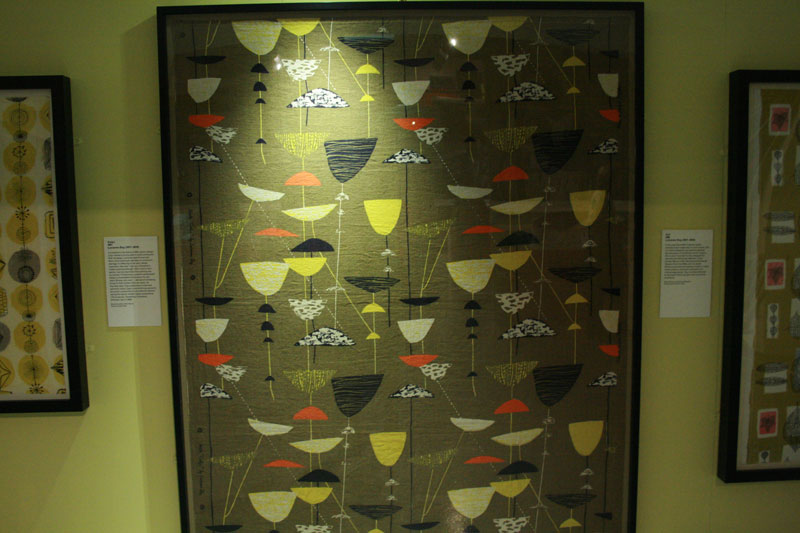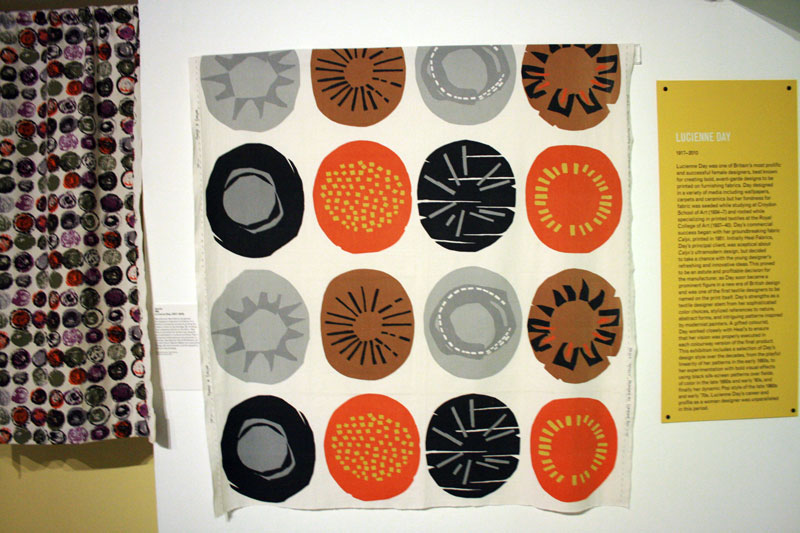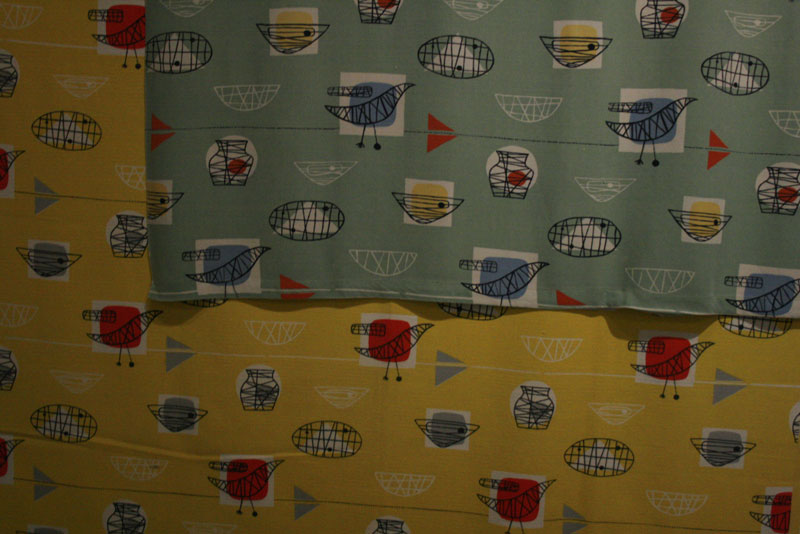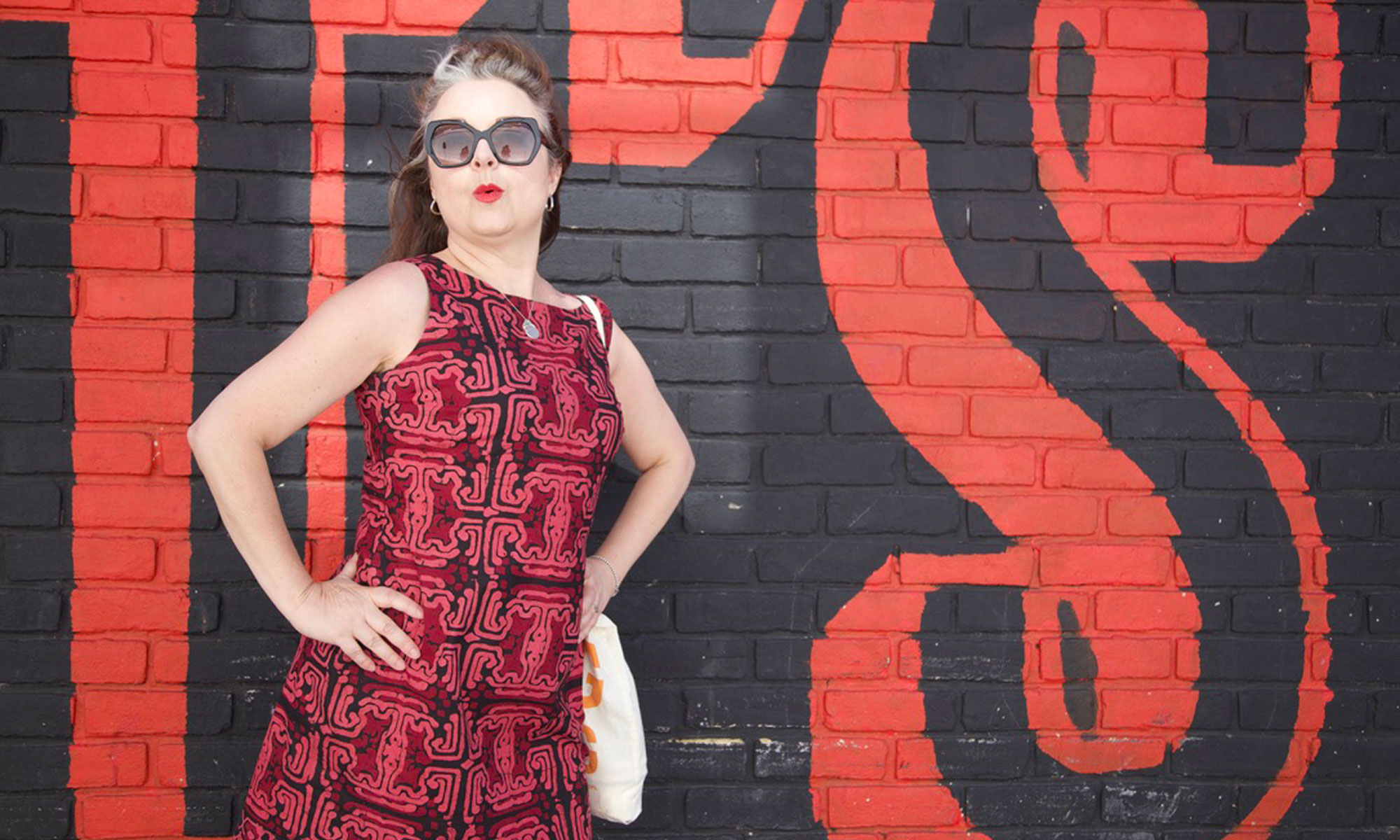Today, I took full advantage of my freelance status, ditched the children for a couple of hours and headed off to the Fashion and Textile Museum, near London Bridge, to see Designing Women: Post War British Textiles exhibition. What a totally self-indulgent treat!
The intro to the exhibition:
“Britain was at the forefront of international textile design in the 1950s and 1960s. The art of textile design radically changed after the Second World War and three women artists working in England in the 1950s were pivotal in this artistic revolution. The drab days of the War were transformed by the fresh, progressive designs of Lucienne Day (1917–2010), Jacqueline Groag (1903–86) and Marian Mahler (1911– 83). Designing Women: Post-war British textiles showcases their work beginning with Lucienne Day’s ‘Calyx’ pattern of 1951, featured at the Festival of Britain, and moving through textile commissions of the 1960s and 70s. The exhibition features more than 100 works.
Original artist designs with bold abstract pattern, as well as the use of saturated colour, marked a dramatic departure from conventional furnishing fabrics. This new wave of bold textile designs, helped to bring the influences of the art world, in its most recent, refreshing, and largely abstract forms, into the contemporary home.”
The influence of modern art is so strong in all the designs of this period. Its very easy to spot some iconic inspiration from Joan Miró, Alexander Calder and Kandinsky.
Lucienne Day, wife of Robin Day, was the most prolific and successful of the designers having kick started the ‘revolution’ with her ‘Calyx’ print in 1951.

Heals, though at first very sceptical, was her first client. The work was considered too modern but the risk proved to be a good and profitable move for both parties. Lucienne Day was the first artist to be credited on the fabric itself.




Lucienne didn’t limit herself to fabric, wallpaper and carpet design…

Jacqueline Groag was born in Czechoslovakia and emigrated from Vienna to London in 1939. She is one of the key designers in Mid Century Britain having worked with some of the foremost textile manufacturers and retailers, including John Lewis, Associated American Artists and David Whitehead Ltd. She also produced laminated surface designs for British Overseas Airways Corporation (BOAC). The same company my mum used to make pilots suits for!


This ‘Pebbles’ design by Jacqueline Groag is so nostalgic for me. As I stood in front of it, it took me back to my home in the 1970s. I can’t be sure that it was exactly this design but similar enough to generate some serious flashbacks! My mum had great taste!

Marian Mahler was Austrian and emigrated to Britain in 1937. As artist and illustrator she combined both skills to generate designs for the younger, yet sophisticated clientele who were looking to create a stylish home. The fabrics were mostly rayon or cotton and the roller printing process made for fast production and an affordable end product. I just love the birds!

The temptation to ‘touch’ was too much!!!



Paule Vézelay was a painter and her skills transferred beautifully to fabric design. So much so that I think a certain Ms Kiely looks to have drawn some serious inspiration, don’t you think?!


And I wasn’t expecting to see any of these fabrics in dress form but just look…

I hope you have enjoyed this little preview. I do apologise for the quality of the photos. No flash photography was allowed so they are a bit grainy and really do not give any of the fabrics the justice they deserve!
Well, best I get on with my real work now… the downside of freelanceness!




Love those patterns and color combinations!
Thanks for stopping by to comment Peter… I thought they might be up your street! 🙂
Oh, what a fun day! Thanks for posting pictures of your adventure. It was fun for me because the Calyx by Lucienne Day (1951) looks so much like the curtains in the Frank Lloyd Wright style home I grew up in. Those curtains covered almost floor to ceiling windows across our entire living room. Fun to see it again. Brings back loads of good memories of that house.
Beth
It was indeed. Thanks Beth. Yes it was all very nostalgic for me too. I never thought my mum was ever trendy but all these designs sent me right back to my childhood! 🙂
Wow Janene, what a wonderful inspirational day you had. Those prints really float my boat – I want to put all your photos on Pinterest! Thank you so much for sharing – as I am unlikely to ever see the exhibition. Going to reblog ya! x
He he… I thought you might like like those pics Trish. In fact I can see that coffee set sitting quite comfortably on your side cabinet!
those are great!! I was disappointed when I visited the museum over the Xmas period, but this show looks way better!
Reblogged this on Mercury – Handmade Fashion and commented:
Reblogged at http://www.bellemegan.wordpress.com
Wow! Love those fabrics. Thanks for sharing!
I love days out like these. The ‘Composure’ print looks so familiar to me from when I was little, mind you, everything in my nan’s house was either brown or orange or brown and orange!!
Fluffy orange cushions, i’m now skipping gleefully down memory lane.
🙂